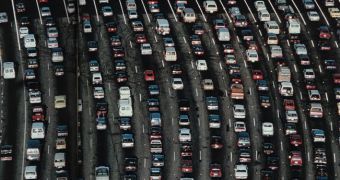According to the U.S. Department of Transportation Statistical Records Office, there are approximately 62 million registered vehicles in the U.S. including trucks, heavy machinery and construction motorized vehicles which are more or less road-legal.
This means that even the wide and straight roads in America will soon become overcrowded and some of them are already. Traffic in major cities is a real headache not only for the drivers wanting to get to work or get out of town for some fresh air, but also for the economy, which suffers important annual losses because of traffic jams and accidents.
Speaking of fresh air, this notion has almost disappeared in most major cities and most traditional methods of dealing with this problem don't quite work. Instead of building more roads, which is costly at best and impossible in some cases, a group of researchers came up with an interesting proposal.
Automated tailgating could be the answer to overpopulated streets, say Debojyoti Mitra and Asis Mazumdar in the Department of Mechanical Engineering at Jadavpur University, Kolkata, India. "Automated highway systems are one of the many approaches that have been suggested to tackle the problems."
If this could work in India, where cars are occupying 10.8% of the capital's urbanized area, then it could also work for the US. More traffic means more pollution, and if no one can prevent people from using their cars, the two scientists suggest using them wisely.
By increasing the distance between cars in a platoon, they could all act like a continuum, thus reducing drag, fuel consumption and occupied road space, while also decreasing noise levels coming from all the moving parts and exhaust gases.
"The leading car in the platoon experiences the highest drag as you would expect but no more than if it were driving alone," explains Mitra, "The second car has a much lower drag coefficient than the first car in a two-car platoon. The middle car experiences the lowest drag in a three-car platoon and the third car in the platoon, starting from the front, experiences the least drag in a four-car platoon."
There is one problem, though, the fact that the driver's reaction time would greatly decrease, that's why new sensors and breaking systems should be installed in new cars, which would use a computer able to react much faster that a human driver, thus assisting him in emergency situations.
"Automated highway systems are one of the many approaches that have been suggested to tackle the problems," concluded Mitra and they could soon become one of the most feasible solutions available.

 14 DAY TRIAL //
14 DAY TRIAL //